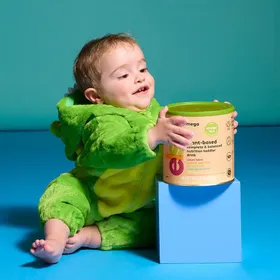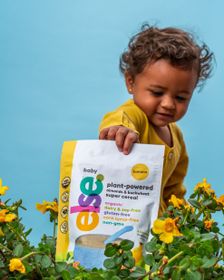Signs Baby is Ready for Weaning: How to Start Solid Foods
Published May 27, 2024

Are you noticing changes in your baby’s behavior and wondering if they might be signs baby is ready for weaning? It’s a pivotal time that calls for a keen eye to discern if your little one is showing readiness for solid foods.
These signs include increased curiosity about what you’re eating, improved head and neck control, and a decrease in the tongue-thrust reflex, all signaling it may be time to introduce the diverse flavors and textures of solid food.
In this article, we’ll guide you through the key indicators to watch for, ensuring you and your baby embark on this important journey with confidence.
Key Takeaways
Babies show readiness for solid foods through interest in meals, improved sitting posture and head control, and diminished tongue-thrust reflex, signaling a developmental readiness for a diverse diet.
Weaning should complement breast milk or formula with a gradual introduction of solid foods around six months of age, starting with purees and progressing to a variety of textures and flavors, including iron-rich and potentially allergenic foods.
Responsive feeding practices are key, with parents guided by the baby’s hunger and fullness cues to determine the frequency and quantity of feedings, while ensuring mealtime safety through supervision and appropriate food preparation to prevent choking.
Understanding Weaning: A Developmental Milestone
The journey from breast milk or formula to a medley of mashed peas and pureed peaches is a significant developmental milestone. Weaning is more than just incorporating new foods into your baby’s diet; it’s a complex transition that encompasses nutritional, immunological, biochemical, and psychological shifts. As your little one’s palate expands beyond the singular taste of milk, their tiny bodies are also learning to digest a variety of nutrients, building immunity, and experiencing new sensory delights.
Amidst this journey, baby-led weaning has emerged as an empowering approach, placing the spoon—quite literally—in your baby’s hands. This method promotes independence as the baby takes the lead in exploring foods at their own pace, choosing what to eat, how much, and how quickly. It’s a beautiful sight to behold: a baby’s eyes lighting up at the discovery of new tastes and textures, their motor skills fine-tuning with each meal. Remember, every baby is unique; some may embrace a spoonful of avocado with gusto, while others might initially be more tentative. Either way, it’s perfectly normal and part of the adventure.
Key Indicators Your Baby Is Prepared for Solid Foods
What signs should you look for to determine if your little one is ready for the adventure of solid foods? It’s all in the cues. The signs are there, like breadcrumbs leading to a gingerbread house, except the breadcrumbs are developmental milestones, and the house is a well-balanced diet of solid food. Your little one will begin to show an interest in food, their head and neck will steady, and that tongue-thrust reflex, once their natural defense against choking, will diminish. These are the telltale indicators that your baby is ready to expand their culinary horizons.
A baby’s readiness for solid foods is a canvas painted with several strokes: curiosity, posture, and physiological changes. Let’s delve into each of these signs in the sections that follow, understanding their significance and how they weave together to signal that it’s time to start introducing solid foods.
Interest in Meals: More Than Just Curiosity
Have you noticed your little observer eyeing your plate with the intensity of a detective? This burgeoning curiosity goes beyond mere observation; it’s a sign that their tiny tummies might be ready for more than just milk. When babies begin reaching for food, showing excitement at meal times, or even fussing with the intention to eat, they are displaying a readiness to join the world of eaters. It’s not just about satisfying hunger—it’s about participating in a fundamental family ritual, exploring new tastes, and learning about the world through food.
Imagine the scene: the family gathered at the table, and there’s your baby, reaching out with a gummy smile, wanting to be part of the action. You offer a spoonful of sweet potato puree, and they open their mouth, eager for this new experience. This is where the weaning journey truly begins—with each open-mouthed giggle and curious glance, your baby is telling you they’re ready for the next step.
Sitting Up and Head Control: The Posture for Eating
A baby’s readiness to eat solid foods isn’t just about their interest in the colorful array on your plate; it’s also about being physically prepared to handle those first spoonfuls safely. Proper head and neck control are crucial because they allow your baby to swallow food without choking. And when your little one can sit upright with minimal support, perhaps in a high chair, they’re in the optimal position to start practicing the art of eating.
Here’s the picture: your baby in their high chair, head steady, eyes bright with anticipation. You present a soft-cooked carrot stick, and they reach out with determination. As they bring it to their mouth, their posture allows them to explore this new texture safely and effectively. With each successful bite and swallow, your baby is mastering the coordination needed for eating.
Diminished Tongue Thrust: Making Way for Solids
The tongue-thrust reflex is like a baby’s natural gatekeeper, ensuring that anything unfamiliar (and potentially harmful) is pushed out of their mouth. But as your baby grows, this reflex naturally diminishes, signaling a readiness for a more diverse diet. When the time comes, and the tongue no longer pushes food out, it’s a green light for the journey into the world of solids to begin.
Picture your baby’s first encounter with a spoonful of pureed peas. Initially, you might see that little tongue push against the spoon—a reflex from their earlier days. But as the reflex fades, the peas stay put, and your baby learns to move them to the back of their mouth, ready to swallow. This simple action is a profound step in your baby’s weaning journey, opening up a universe of flavors and textures waiting to be explored.
Nutrition Transition: From Milk to Solids
As your baby steps into this thrilling new phase, it’s important to know when to start solid foods. Keep in mind that breast milk or formula remains their nutritional North Star until around six months of age. The transition to solid foods should be a gradual one, starting with small tastes that complement, not replace, milk feeds. This phased approach allows your baby to learn how to swallow solids and adapt to new textures at a pace that’s right for them, making the process of starting solid foods a smooth experience.
Around the six-month mark, the majority of babies are prepared to embark on their journey into the world of solid foods, starting with a few spoonfuls of puree alongside their regular milk feeds. As their skills and confidence grow, so will the variety of foods on their plate, gradually introducing more solid foods. From meats to cereals, vegetables to fruits, and eggs to fish, this nutritional tapestry weaves together, ensuring that by their first birthday, your little one’s diet is as colorful and diverse as can be.
Balancing Breast Milk or Formula with New Tastes
As you acquaint your baby with the delightful world of solid foods, remember that breast milk, cow’s milk, or formula milk continues to be the bedrock of their diet, especially for breastfed babies. This precious liquid continues to provide the essential nutrients needed for growth and development while your baby gets accustomed to new flavors and textures. It’s like adding spices to a well-loved dish; the foundation remains the same but is now enhanced with new tastes.
Introducing your baby to vegetables early on can set the stage for a lifetime of healthy eating habits as part of a balanced baby’s diet. These first encounters with baby food are not just about filling a belly but about cultivating a palate. Imagine the joy of watching your baby’s face light up with each new taste—each spoonful of carrot puree, each lick of mashed peas, is a building block in their lifelong relationship with food. Offering a variety of flavors, rather than the same foods repeatedly, can help develop their taste preferences.
Introducing Textures: From Purees to Finger Foods
Navigating the range of textures is as vital as introducing new flavors. Starting with smooth purees, your baby will slowly graduate to more complex textures, like:
soft lumps
mashed foods
finely chopped foods
finger foods
This progression is tailored to meet your baby’s developing motor skills, allowing them to handle and enjoy a variety of textures by their first birthday.
The transition from purees to finger foods is not a race; it’s a natural progression as your baby’s abilities evolve. By offering a range of textures over time, you’re helping to lay the foundations for a child who is open to trying new foods and enjoying them in all their forms. Whether it’s the squish of a ripe banana or the gentle resistance of a steamed broccoli floret, each new texture is an adventure, a step towards eating the same healthy family foods—with a few safety modifications, of course.
First Foods: What to Serve When Starting Weaning
Selecting the appropriate first foods lays the foundation for a lifetime of healthy eating habits. It’s essential to include a variety of nutrient-rich foods that are especially packed with essential nutrients like iron, proteins, and fats to support your baby’s growth and development. When considering what to serve, think about soft fruits and cooked vegetables that are both safe and nutritious, such as:
banana
avocado
mango
sweet potato
zucchini
The size and texture of these first foods are critical. Offer them in forms that are easy for your baby to handle and consume safely, like strips the size of an adult’s pinky finger, and as their feeding skills improve, you can transition to smaller, diced pieces. This attention to detail ensures that your baby’s first experiences with solid foods are both enjoyable and safe.
Vegetables and Fruits: Starting with Single Flavors
Embarking on the weaning journey with single-ingredient fruits and vegetables is a wonderful way to acquaint your baby with individual flavors. By offering single flavors, like mango slices or avocado strips, you allow your baby to form a relationship with each taste, one at a time. Vegetables like steamed broccoli florets or soft zucchini sticks can serve as the perfect introduction to the savory side of the flavor spectrum.
To monitor for any potential allergies and ensure that your baby tolerates the new food well, introduce new single-ingredient foods every 3 to 5 days. Starting with less sweet vegetables may also help broaden your baby’s taste preferences, reducing the likelihood of developing picky eating behaviors later on. Each new vegetable or fruit is not just a meal but a lesson in taste, texture, and the joy of eating.
Iron-Rich Foods: Supporting Baby's Growth
Iron holds a crucial position in your baby’s diet, fostering their speedy growth and cognitive development. As natural iron stores start to deplete, it’s crucial to incorporate iron-rich foods like cooked beef, pork, lamb, and fish into their diet. For those seeking meat alternatives, iron-fortified tofu is an excellent choice, and legumes like chickpeas and lentils can also be included to bolster iron intake.
Vegetables such as spinach, kale, and peas are not only iron-rich but also incredibly versatile—they can be mixed into purees for younger babies or served as finger foods for those a bit older. Whether you’re spoon-feeding or practicing baby-led weaning, presenting these iron-rich foods in consumable, safe forms ensures your baby receives all the benefits without the risk.
Introducing Allergens: Timely and Careful Approach
When it comes to potential allergens, the adage “timing is everything” rings particularly true. Introducing potentially allergenic foods early on is recommended, as delaying their introduction does not reduce the risk of allergies. Start with a tiny amount of a new potential allergen, ideally earlier in the day, and observe for any reactions. If all is well, you can gradually increase the serving, following a schedule of one single ingredient every few days to keep track of any allergic responses.
Awareness and preparation are key when introducing new foods that may cause an allergic reaction. Make sure all caregivers are informed about the signs of an allergic reaction and know how to respond appropriately, especially if your baby has a higher risk of allergies. And remember, once a food is safely introduced, continue offering it regularly to minimize the likelihood of an allergy developing in the future.
Creating a Weaning Schedule: Frequency and Quantity
A meticulously planned weaning schedule can transform the process to introduce solid foods into a harmonious journey. Here are some steps to follow:
Begin with offering solid foods once a day in small amounts.
Let your baby’s appetite guide you on when to increase the frequency and quantity.
As your baby grows, their appetite will naturally fluctuate, signaling when they are ready for more or perhaps a little less.
During the weaning process, your baby’s hunger and fullness cues are your best indicators for how much to offer. As they approach the 9-12 month mark and begin self-feeding with finger foods, you’ll notice these cues becoming more pronounced. The 4 to 9-month window is a golden opportunity to introduce a variety of new tastes and textures, as babies are most receptive to new foods during this time.
Recognizing Hunger and Fullness Cues
Deciphering your baby’s hunger and satiety signals is like mastering a new language, one that is vital for responsive feeding. From rooting to chewing on hands, making sucking motions, and displaying eagerness towards food, these are your baby’s ways of communicating their hunger. On the flip side, signs of fullness may include turning their head away from food, becoming easily distracted, or pushing the bottle or breast away. Understanding and respecting these cues allows your baby to regulate their own intake, fostering a healthy relationship with food from the start.
Imagine you’re spoon-feeding your little one, and they start to lean in, mouth open, ready for the next bite. This is a clear hunger cue. Conversely, if halfway through the meal they begin to fuss or turn away, they’re likely signaling that they’ve had enough. By tuning into these cues, you ensure that your baby eats the right amount for their needs, making mealtimes a positive, stress-free experience for both of you.
How Much Food Is Enough?
Determining the right amount of food for your baby can feel like a guessing game, but it doesn’t have to be. Starting with small portions, such as a few pieces of finger food or a couple of tablespoons of mashed food, is a sensible approach. Be prepared for variability; a baby’s appetite can fluctuate daily, influenced by growth spurts, teething, or simply their mood. By remaining flexible and attentive to your baby’s cues, you’ll find the sweet spot between too little and too much, ensuring they receive all the nutrients they need without overfeeding or underfeeding.
Consider each meal an experiment of sorts. Some days your baby might gobble up every morsel with gusto, while on others, they might show less interest. That’s perfectly normal. The key is to:
Offer a variety of nutrient-rich foods in manageable portions
Adjust based on your baby’s response
Cater to their needs
Encourage a joyous exploration of the vast culinary landscape before them
Weaning Safety: Preventing Choking and Ensuring Hygiene
Despite weaning being an exciting time, it necessitates enhanced caution to guarantee your baby’s safety. Here are some tips to minimize choking risks:
Use small pieces, purees, and blended foods.
Alter the shape of small round foods like grapes and cherry tomatoes into safer forms such as sticks or batons.
Always peel fruit, remove pits and bones.
Keep hard foods like nuts and raw carrots off the menu for now.
Mealtime requires your undivided attention. Here are some important guidelines to follow:
Never leave your baby unattended while eating.
Ensure your baby is seated upright and able to bring food to their mouth independently.
Keep distractions at bay so you can focus on your baby.
React swiftly if your baby shows any signs of distress.
By following these guidelines, you can ensure a safe and enjoyable mealtime for your baby.
Remember, supervision is not just about preventing accidents; it’s also about sharing the joy of discovery as your baby explores new tastes and textures.
Summary
Embarking on the weaning journey with your baby is a richly rewarding experience that sets the foundation for a lifetime of healthy eating habits. From recognizing your baby’s readiness cues to introducing a diverse palette of tastes and textures, each step is a building block in their nutritional development. Balancing breast milk or formula with solid foods, ensuring safety, and being responsive to your baby’s hunger and fullness cues are all pivotal elements of successful weaning.
As you navigate this exciting phase, remember that patience, observation, and flexibility are your best tools. Every baby is unique, and their journey to solid foods will be too. Embrace the mess, the laughter, and the occasional puzzled faces. With each new taste and texture, your baby is not just eating; they’re learning, growing, and thriving. Bon appétit to your little gourmet!
Frequently Asked Questions
When should I start introducing solid foods to my baby?
You should start introducing solid foods to your baby around 6 months of age, when they show signs of readiness such as good head and neck control and an interest in food. This is important for their development.
How do I know if my baby is full or still hungry?
Watch for hunger cues such as leaning towards food and opening their mouth, and signs of fullness like turning away or becoming distracted, to determine if your baby is still hungry or full. Trusting these cues will help you understand how much to feed your baby.
What are the best first foods to introduce to my baby?
Introduce soft fruits like bananas, avocados, and mangos, as well as cooked vegetables such as sweet potatoes and zucchinis to your baby as their first foods, served in sizes and textures that are easy for them to handle.
How should I introduce allergenic foods to my baby?
Introduce potentially allergenic foods one at a time in small amounts and watch for any reactions, gradually increasing the portion size if there are no adverse reactions.
Can I still breastfeed once my baby starts eating solid foods?
Yes, it's recommended to continue breastfeeding alongside introducing solid foods until at least 12 months of age, as milk feeds should remain the primary source of nutrition.
The content and advice provided in this article is for informational purposes only and is not a substitute for medical diagnosis, treatment, advice for specific medical conditions. Always consult a pediatrician to understand the individual needs of your child. The article expresses the views of the brand editor.









